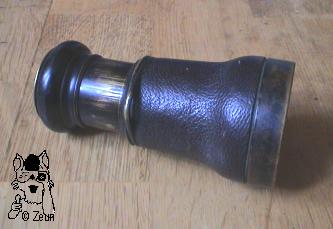Offiziers-FeldglasDieses kleine, aber immerhin 217g schwere, Galileiische Beobachtungsglas hat einen lederummantelten Objektivtubus aus Messing, einen Okularauszugstubus, der ursprünglich komplett schwarz lackiert war und eine Gesichtsfeldblende enthält, sowie einen großen Okularstück. Oben am Objektivtubus befinden sich zwei Halteösen für eine Trageriemen. Am Okularrand befindet sich ein kleiner Knopf, der, wenn man ihn nach außen zieht, im Inneren des Okulars eine Gelbfilterscheibe vor die Okularlinse klappt. Letzteres lässt auf einen militärischen Gebrauch schließen - daher wahrscheinlioch ein Offiziers Feldglass aus dem 19. Jahrhundert bis spätestens 1. Weltkrieg. |
Officer's Spy GlassThis small, but yet 217g weighing, Galilean spy glass has a leather covered brass objective tube, and a draw tube for the eyepiece. This ocular tube was originally painted black. It still has a diaphragm. The eyecup is quite big, due to an incorporated yellow filter that can be flipped before the ocular lens by pulling out a tiny knob. This reflects a military use of the glass - hence being an officer's glass dating from the 19th century or World War I at the latest. At the top end of the objective tube are two strap lugs. |


| Zusammengeschoben ist es 9cm, ausgezogen 11,5cm. Der Durchmesser des Objektivtubus ist außen 5,4cm, oben 4cm; die Augenmuschel ist 4,5cm, die außenliegende Okularlinse 3cm im Durchmesser. Die Austrittspupille ist 10mm, bei einem Objektivlisnendurchmesser von 40mm, so dass die Vergrößerung bei ca. 4fach liegt. | It is 9cm closed, and 11.5cm opened. The objective tube diameter is 5.4cm at its outer end, and 4cm at the ocualr tube end. The eye-cup measures 4.5cm, the lens facing the eye 3cm. Having an exit pupil of 10mm and a objective lens of 40mm, the magnification must be about 4 times. |
Fotos: Zeun

